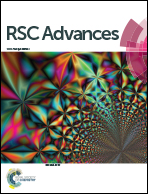Scalable preparation of silicon@graphite/carbon microspheres as high-performance lithium-ion battery anode materials†
Abstract
Silicon materials have received extensive research interest due to their high specific capacity of 3579 mA h g−1 and appropriate potential of approximately 0.4 V vs. Li/Li+. However, silicon materials suffer from poor cycling stability due to the intrinsic large volume changes upon cycling. In this work, silicon@flake-graphite/amorphous-carbon (Si@FG/C) composites were prepared by a controllable, scalable method. The Si@FG/C composites exhibit a porous spherical shape composed of Si nanoparticles, flake-like graphite and amorphous carbon. The pores in porous Si@FG/C can buffer the volume changes of Si upon cycling. The amorphous carbon provides a conducting effect for Si and fixes Si nanoparticles on the FG during cycling. This unique structure leads to structural stability of the electrode and thereby good cycling stability. A capacity retention of 90% can be achieved for Si@FG/C-1 over 300 cycles at 500 mA g−1. The composites also exhibit good rate capability due to the porous structure and effective conductive networks constructed by FG and amorphous carbon. Among the samples, Si@FG/C-3 demonstrates the best rate capability, where a capacity of 200 mA h g−1 can be obtained at a current density as high as 5 A g−1.


 Please wait while we load your content...
Please wait while we load your content...